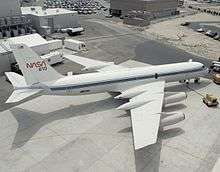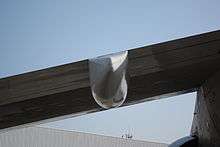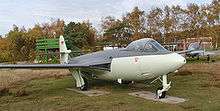Anti-shock body
An anti-shock body (also known as Whitcomb body or Küchemann carrot) is a pod positioned on the leading edge or trailing edge of an aircraft's aerodynamic surfaces. Its purpose is to reduce wave drag while travelling at transonic speeds (Mach 0.8–1.0), which is the typical cruising speed of conventional jet airliners.

The anti-shock body was effectively a means of implementing the recently-developed area rule. Developed during the early 1950s, it was used on the aircraft of various powers of the era, including the United States, the Soviet Union, and the United Kingdom. Examples of its implementation including the Tupolev Tu-16 and Handley Page Victor strategic bombers and the Convair 990 airliner. However, the anti-shock body has largely become unnecessary, and thus is rarely used, due to the emergence of other means of reducing wave drag, such as the supercritical wing.
Theory
The theory behind the anti-shock body was independently developed during the early 1950s by a pair of aerodynamists, Richard Whitcomb at NASA and Dietrich Küchemann at the British Royal Aircraft Establishment.[1][2] The anti-shock body, which was alternatively referred to as "Whitcomb bodies" or "Küchemann carrots", is closely associated with the area rule, a recent innovation of the era to minimise wave drag by having a cross-sectional area which changes smoothly along the length of the aircraft.[3][4]
The design of the anti-shock body uses the Area Rule as its core operating principle, achieving a reduction in wave drag to improve fuel efficiency.[5][6] Specifically, it counteracts and breaks up drag-generating shock waves that are generally produced by the flow of air as it moves towards the trailing edge of the wing, reducing negative buffeting tendencies and increasing aerodynamic efficiency.[2][7] Testing determined that such devices resulted in a signficant drop in wave drag across various wing configurations.[8] In addition to its traditional wave drag minimising function, anti-shock bodies can also serve a dual purpose as undercarriage bogie fairings, or for housing equipment such as chaff dispensers.[9]
In the Soviet Union, the anti-shock body was apparently developed at the TsAGI research institute.
Implementations
Wing trailing edge

Multiple efforts to implement this new aerodynamic were quickly embarked upon. The anti-shock body was first applied within the Soviet Union to the Tupolev Tu-16, a strategic bomber that performed its first flight during April 1952. Anti-shock bodies were to remain a distinctive feature of present on many of Tupolev's other products, including the Tupolev Tu-154, a trijet airliner introduced during the early 1970s.
In the west, anti-shock bodies appeared on multiple western aircraft of the mid to late 1950s, such as the Convair 990, an American jet-powered airliner that cruised at a speed of Mach 0.91.[10] In the United Kingdom, later models of the Handley Page Victor, a strategic bomber operated by the Royal Air Force, was also furnished with the feature, which was sometimes referred to as "speed pods".[9]
However, modern jet aircraft harness supercritical airfoils, which decrease wave drag significantly.[10] Further optimization can be achieved through careful design of wing body fairings, engine nacelles, flap track fairings, and wingtip fuel tanks. Due to the prevalence of supercritical airfoils, other design features with the sole purpose of minimising wave drag (such as the anti-shock bodies on the Convair 990) are rare in modern aircraft.
Leading edge root

The Hawker Sea Hawk, an early jet-powered ground attack aircraft, also made use of anti-shock bodies. During testing of the prototypes, a relatively high degree of tail drag was encountered when approaching transonic speeds. As a means of resolving this negative tendency, an anti-shock body was subsequently fitted to the leading edge of the junction between the vertical fin and tailplane.
References
Citations
- Wallace, Lane E. "The Whitcomb Area Rule: NACA Aerodynamics Research and Innovation". history.nasa.gov. Retrieved 27 June 2020.
- Barnard and Philpott 2010, p. 254.
- Reis, Ricardo (1 December 2014). "Coca-Cola bottles and carrots". upmagazine-tap.com.
- Hallion, Richard P. "Richard Whitcomb's Triple Play". airforcemag.com. Retrieved 1 February 2010.
- Barnard and Philpott 2010, pp. 243-254.
- Bushnell, Dennis M. (2004). "Shock Wave Drag Reduction". Annual Review of Fluid Mechanics.
- Küchemann, Dietrich (January 1957). "Methods of Reducing the Transonic Drag of Swept - Back Wings at Zero Lift". The Aeronautical Journal. pp. 37–42.
- McDevitt, John B. and Robert A. Taylor (16 May 1957). "An Investigation of Wing-Body Junction Interference Effects at Transonic Speeds for Several Swept-Wing and Body combinations" (PDF). naca.central.cranfield.ac.uk.CS1 maint: uses authors parameter (link)
- ap Rees Air Pictorial June 1972, p. 222.
- "NASA and the Jet Age". airandspace.si.edu. Retrieved 27 June 2020.
Bibliography
- ap Rees, Elfan. "Handley Page Victor: Part 2". Air Pictorial, June 1972, Vol. 34, No 6., pp. 220–226.
- Barnard, R. H. and D. R. Philpott. Aircraft Flight: A Description of the Physical Principles of Aircraft Flight. Pearson Education, 2010. ISBN 0-2737-3098-3.
External links
| Wikimedia Commons has media related to Anti-shock bodies. |